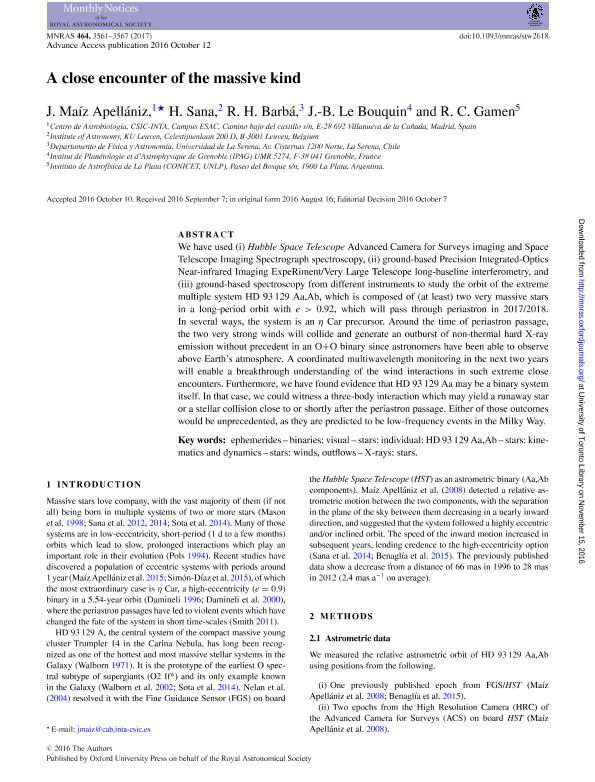Mostrar el registro sencillo del ítem
dc.contributor.author
Maíz Apellániz, Jesús

dc.contributor.author
Sana, H.
dc.contributor.author
Barba, Rodolfo Hector

dc.contributor.author
Le Bouquin, J.B.
dc.contributor.author
Gamen, Roberto Claudio

dc.date.available
2019-09-24T17:33:58Z
dc.date.issued
2017-01
dc.identifier.citation
Maíz Apellániz, Jesús; Sana, H.; Barba, Rodolfo Hector; Le Bouquin, J.B.; Gamen, Roberto Claudio; A close encounter of the massive kind; Wiley Blackwell Publishing, Inc; Monthly Notices of the Royal Astronomical Society; 464; 1-2017; 3561-3568
dc.identifier.issn
0035-8711
dc.identifier.uri
http://hdl.handle.net/11336/84292
dc.description.abstract
We have used (a) HST ACS imaging and STIS spectroscopy, (b) ground-basedPIONIER/VLT long-baseline interferometry, and (c) ground-basedspectroscopy from different instruments to study the orbit of theextreme multiple system HD 93 129 Aa,Ab, which is composed of (at least)two very massive stars in a long-period orbit with e>0.92 that willpass through periastron in 2017/2018. In several ways, the system is aneta Car precursor. Around the time of periastron passage the two verystrong winds will collide and generate an outburst of non-thermal hardX-ray emission without precedent in an O+O binary since astronomers havebeen able to observe above Earth's atmosphere. A coordinatedmultiwavelength monitoring in the next two years will enable abreakthrough understanding of the wind interactions in such extremeclose encounters. Furthermore, we have found evidence that HD 93 129 Aamay be a binary system itself. In that case, we could witness athree-body interaction that may yield a runaway star or a stellarcollision close to or shortly after the periastron passage. Either ofthose outcomes would be unprecedented, as they are predicted to below-frequency events in the Milky Way.
dc.format
application/pdf
dc.language.iso
eng
dc.publisher
Wiley Blackwell Publishing, Inc

dc.rights
info:eu-repo/semantics/openAccess
dc.rights.uri
https://creativecommons.org/licenses/by-nc-sa/2.5/ar/
dc.subject
Ephemerides
dc.subject
Binaries: Visual
dc.subject
Stars: Individual: Hd 93 129 Aa,Ab
dc.subject
Stars: Kinematics And Dynamics
dc.subject
Stars: Winds, Outflows
dc.subject
X-Rays: Stars.
dc.subject.classification
Astronomía

dc.subject.classification
Ciencias Físicas

dc.subject.classification
CIENCIAS NATURALES Y EXACTAS

dc.title
A close encounter of the massive kind
dc.type
info:eu-repo/semantics/article
dc.type
info:ar-repo/semantics/artículo
dc.type
info:eu-repo/semantics/publishedVersion
dc.date.updated
2019-05-23T20:34:49Z
dc.journal.volume
464
dc.journal.pagination
3561-3568
dc.journal.pais
Reino Unido

dc.journal.ciudad
Londres
dc.description.fil
Fil: Maíz Apellániz, Jesús. Centro de Astrobiología; España
dc.description.fil
Fil: Sana, H.. Institute of Astronomy, KU Leuven; Bélgica
dc.description.fil
Fil: Barba, Rodolfo Hector. Universidad de La Serena; Chile
dc.description.fil
Fil: Le Bouquin, J.B.. Institut de Planetologie et d’Astrophysique de Grenoble; Francia
dc.description.fil
Fil: Gamen, Roberto Claudio. Consejo Nacional de Investigaciones Científicas y Técnicas. Centro Científico Tecnológico Conicet - La Plata. Instituto de Astrofísica La Plata. Universidad Nacional de La Plata. Facultad de Ciencias Astronómicas y Geofísicas. Instituto de Astrofísica La Plata; Argentina
dc.journal.title
Monthly Notices of the Royal Astronomical Society

dc.relation.alternativeid
info:eu-repo/semantics/altIdentifier/doi/http://dx.doi.org/10.1093/mnras/stw2618
dc.relation.alternativeid
info:eu-repo/semantics/altIdentifier/url/https://academic.oup.com/mnras/article/464/3/3561/2514582
Archivos asociados
